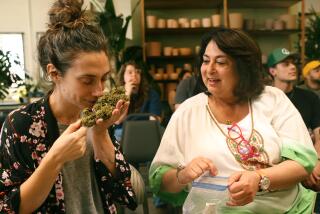Use the Thyme on Your Hands for the Right Reasons
It’s pronounced time, with a silent h , and the many species and varieties of this herb can be divided into two groups--the creeping ground covers and those that grow upright. Although all thyme leaves are edible, generally the ground covers are considered ornamental, while the uprights are more likely to be used for culinary purposes. There are exceptions, which will be noted later under the specific types.
A good place to view several different varieties of thyme is at Huntington Library, Art Collections and Botanical Gardens in San Marino. On a recent walk through the herb garden with Shirley Kerins, consultant in charge of the area, she confirmed our premise that thyme is a good herb for beginner gardeners.
Good Drainage Needed
“It’s not that demanding, and very forgiving,” Kerins said. Except for needing good drainage to prevent root rot, thyme is very easy to grow.
As we rubbed and sniffed the different varieties around the garden, it also was apparent that thyme thrives in either sun or partial shade. Kerins explained that the creeping ground-cover varieties grow well between stepping stones, where their roots stay cool. She also showed how some of the upright species had been cultivated into low hedges or borders.
Kerins was quick to point out that here in Southern California, where plants grow year-round, it’s best to replace thyme plants, although they are perennials, every three to five years. By then, “they’ve become very woody, and you’ve certainly gotten your money’s worth,” Kerins said.
Thyme may be grown from seeds, but this member of the mint family hybridizes easily, so to be certain of growing the variety desired, it’s best to start with small plants readily available at nurseries. It’s also possible to propagate thyme by taking a small cutting, two to three inches long, from a healthy plant.
Kerins explained that the cutting should not include any of the plant’s stem. It needs to be long enough to strip off the leaves of at least three nodes, then should be cut just below a fourth node. Dip the cut end in rooting compound and insert the tiny plant in sand.
To make a mini-greenhouse for cuttings, Kerin suggests removing one side from a milk carton and closing the open end. Pierce holes for drainage along each side about -inch from the bottom edge. Fill this container with damp sand, then after adding the tiny plants, cover the entire container with a plastic bag and close with a twist tie. Place it outside in a shady place. Open to check the plants every three days and water only if the sand has dried out. When the plants resist being tugged gently, you’ll know they’ve rooted.
Kerins also demonstrated the natural, or what she calls “lazy way,” of rooting thyme. As the plants age, they bend downward. Push a portion of the plant’s edge down to the ground, pile soil on top and weight it with a rock. In very little time the plants will root themselves.
Drought-Resistant
Except when being grown in containers, thyme seldom needs supplementary feeding. It’s also fairly drought-resistant, needing water less frequently than some herbs. Clair Martin, curator of the rose garden at the Huntington, currently is experimenting with growing thyme under rose bushes adjacent to the herb garden. It’ll be a year before conclusions can be drawn, but the object is to determine whether roses and thyme can tolerate the same amount of water.
When you harvest thyme, it’s important just to snip the ends, not cut down into the woody stems, Kerins stressed. Although you can dry thyme, it’s really not necessary in this climate, where fresh is available any time of year.
Thyme is an essential component of bouquet garni --along with marjoram, parsley and bay leaf--and as such, flavors many, many dishes.
CULINARY VARIETIES
Common Thyme (Thymus vulgaris)-- the species most often used for culinary purposes. A semi-woody, shrubby perennial that grows six to 12 inches high and can spread 1 1/2 feet or more. The oval gray-green leaves are about one-quarter inch long. Small flowers grow at the ends of the stems in loose spikes. The following are some variations:
English (T. vulgaris)-- broader green leaves.
French (T. vulgaris var. )-- narrow, fragrant gray-green leaves with a milder flavor and small round pink flowers. Said to be preferred by French chefs.
Lemon (T.s. vulgaris)-- lemon-scented leaves variegated with yellow. Recommended for tea or in salads.
ORNAMENTAL UPRIGHTS
Golden (T.x. citriodorus Aureus ) --lemon-scented with golden foliage.
Silver (T.s. Argenteus ) --small lemon-scented leaves variegated with silver. Excellent for growing in rock gardens.
Cat Thyme (Teucrium marum)-- small gray leaves and lilac flowers. Seems to be an irresistible attraction for cats.
GROUND-COVERS
Caraway-scented (T. herba-barona)-- mat-like ground cover with tiny lavender blooms and caraway aroma and flavor. May be used for culinary purposes in place of caraway seeds.
Woolly (T. lanuginosus)-- ground cover with tiny gray leaves.
Nutmeg--tiny leaves and lavender flowers.






